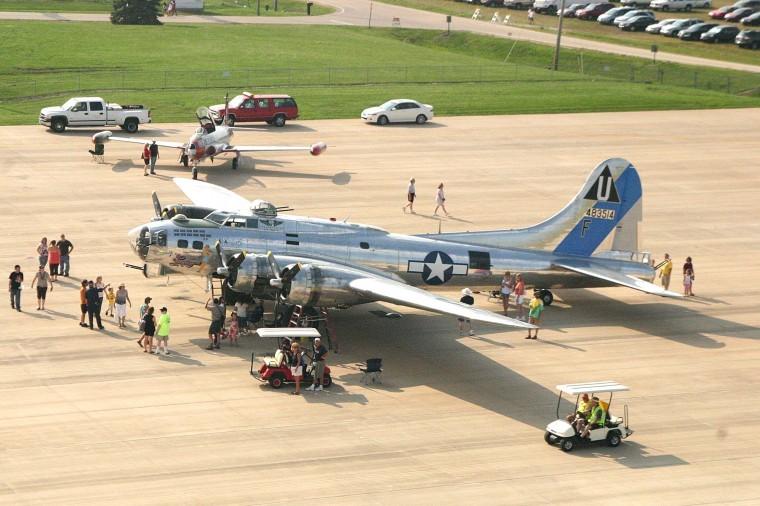Flying high above DeKalb: A first-hand account of a ride in a B-17 bomber
Visitors at the DeKalb Cornfest inspect a B-17 aircraft brought to the fest by the Arizona branch of the Commemorative Air Force Saturday Aug. 21 at the DeKalb Municipal Airport.
August 24, 2010
As a child, one of my favorite games to play was running around the house with my model B-17 bomber, pretending to be the lead bomber over Nazi-occupied France.
On Aug. 16, I was given the opportunity to fly in a B-17 over DeKalb and Northern Illinois University’s campus courtesy of Shaw Suburban Media, specifically Lisa Angel. Lisa was also the event planner for Corn Fest this past weekend.
For the entirety of the 20-minute flight, I was not a 21 year old, 6’3″, 285 lb. college student. I was living my childhood dream of liberating Europe; I was the nose gunner on a B-17.
The Sentimental Journey was built in 1944 and served in the Pacific after WWII. It may have been used as a nuclear testing bomber, but those records remain classified. After the plane’s retirement from duty in 1959, it was kept in storage until 1978 when it was donated to the Commemorative Air Force out of Arizona.
The Arizona branch of the Commemorative Air Force is run solely by volunteers and based out of Mesa, Ariz. An organization whose mission is “To preserve aviation history and wartime memorabilia for future generations,” I later learned the plane was completely disassembled and restored to original WWII configuration by the volunteers at CAF.
The most fully restored of all remaining B-17s, Sentimental Journey is one of nearly 13,000 manufactured “Flying Fortresses.” Of these, only 50 remain and of the 50, only eight are still able to fly. She weighs 65,000 lbs, has a flight range of nearly 4,000 miles on one tank of gas and can climb to over 36,000 ft. with an 8,000 lb. bomb load.
For 20 minutes, I was a part of the crew. For 20 minutes, I was the nose gunner.
After four or five majestic passes over the retirement home (a salute to veterans,) the plane came in to land and passed the hangar at around 200 feet sounding like thunder. Everything around us shook. An anonymous veteran behind me stared in awe before whispering, “Imagine a thousand.”
Once I was allowed inside, it was very easy to get an appreciation for what our veterans really did for us. The plane is held together with .25 inch aluminum sheet and a steel skeleton; no surface is bullet proof, in fact in the face of .50 cal bullets and anti-aircraft guns one might say it is bullet friendly. No seat belt, cramped quarters and lots of jagged edges.
The pilot fired up the four, 1200 horse power engines and we taxied off the runway into the air. Everything was shaking; guns, walls, floor, windows and especially me. I couldn’t contain my laughter and pure joy as we flew over DeKalb, the engines literally deafening and the scenery incredible. I would later realize that during that 20-minute flight, I had taken 560 pictures.
The stench of gas was overpowering. It’s exciting knowing I’m feeling the same emotion our soldiers must have in WWII; that I could be blown up any moment by a stray spark. It is however disconcerting knowing I could be roasted mid-air in a 66-year-old airplane. One of the crew appeared in the hatch, and I did my best to scream into his ear, to ask if the smell was normal. He smiled and gave me the thumbs up; neither of us heard what I had yelled at the top of my voice. I sat down, smiled and thanked God that no zeros or anti-aircraft guns were chasing me.
We landed, I thanked the crew, and patted the side of the rickety old airplane that remains resolute and refuses to retire to a museum in the face of old age. Like many other members of the greatest generation, this plane not only fought for our freedom but remains present as a living piece of history, a time machine to one of the greatest eras in American history.







